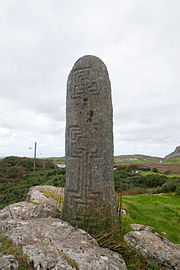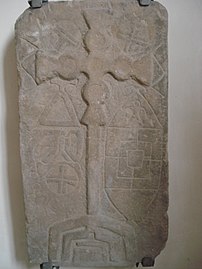Bredenstein
The Bredenstein , a so-called character stone , is located near the B 497 in the Solling-Vogler Nature Park , about two kilometers south of Neuhaus im Solling in Lower Saxony .
The stone is already drawn on the map of the Solling from 1603, which Johannes Krabbe (1553–1616) made on behalf of Duke Heinrich Julius .
description
On a side stream of the Ahle , not far from its source, there is a sandstone block measuring approximately 1.0 × 0.7 m and 0.5 m high . It bears an incision in the shape of a 40 cm large mill set on its surface . In the middle there is a small bowl .
Interpretation and comparative works
Concluding scientific studies on the origins and significance of the Bredenstein are not available.
Similar representations from prehistoric or historically older times are known from all over Europe, for example in caves in the forest of Fontainebleau or in rock carvings in Valcamonica .
More recent patterns come from an originally presumably Iron Age cross-slab from Glencolumbkille in Ireland . A mill game also adorns the Ernstkirchen picture stone , which is dated to the end of the 8th century. The incisions in such vertical cross plates or gate beams were apparently not used as a game of the mill, but represent religious or cult symbols. According to Dietrich Evers , such petroglyphs represent a primitive cosmological model. They are reflected in terms such as upper, middle and underworld or later reflected in heaven , earth and hell.
Regional comparative works can be found on a grave slab in the crypt of St. Wiperti (Quedlinburg) and on a beam stored in the Museum Holzminden .
Because of the depression in the middle of the Bredenstein, the depiction on a menhir, one of the rock art sites in Austria , discovered by Hans Fink not far from the Pfeffersberg castle ruins , shows a remarkable resemblance.
According to an interpretation by Marie EP König , such pictorial symbolism visualizes the worldview of the creator. Hemispherical depressions, such as on a bowl stone near Elvas or in the middle of the Bredenstein, were interpreted by Gerda Weiler as a symbol of the cosmic and earthly female body. Jutta Voss put forward the thesis that this original symbolism evolved into cultic vessels and that the Christian chalice ultimately emerged.
In contrast, a profane use of the Bredenstein as a boundary stone for the property of a nearby settlement was discussed. In 1876, about 2 km south of the Bredenstein in Schönhagen, a house built in 1583 was demolished, as the pastor there documented. According to the pastor's report, a 2-foot-high rectangular stone was placed on the chimney of the house with a mill pattern worked into it.
A comparative example from medieval times is a playable, because horizontally usable, mill game engraved in stone, which was found in Nevern Castle .
An etymological investigation of the Bredenstein points to the origin of “breten”, deciding by throwing, so playing mill. But since in the figurative sense also speaking right is meant, i.e. a place of court, only the temporal classification in the late early Middle Ages appears possible, derived from the development of the settlement in Solling.
A first investigation into the origin of the name referred to the name "Bredensteinisch Bruch" recorded in 1587 for the forest place with the Bredenstein. According to this, there is no derivation of “broad stone”, but of “width”, i.e. H. manorial land to accept. In addition, there is no connection with a border location, as the forest location was controversial at the time between the Fürstenberg office and the Erichsburg office .
literature
- Siegmund Oehrl: The Bredenstein near Neuhaus and the importance of the “Mühlespiel” scratches . Sollinger Heimatblätter 2008, issue 3.
- Norbert Rikus: Prehistoric cult stones in the Solling . In: primeval and early times. Issue 2 + 3 1986
- Otfried Ruhlender: memorial stones, memorials, boundary and cross stones in Solling . New edition 2009
- F. Mandl: The mill game representations on rock in the Northern Limestone Alps. In: Announcements from ANISA. Issue 1/2 1994
- Ernst Andreas Friedrich : The Bredenstein im Solling , pp. 24-25, in: If stones could talk , Volume III, Landbuch-Verlag, Hanover 1995, ISBN 3-7842-0515-1 .
Web links
Individual evidence
- ^ Pictures from Glencolumbkille
- ↑ "Mühlespiel" in the Tschötscher Heide
- ↑ Erni Kutter: The cult of the three virgins, 2003, pp. 76-77
- ↑ Erni Kutter: The Cult Of The Three Virgins, 2003, p. 75
- ↑ Erni Kutter: The Cult Of The Three Virgins, 2003, p. 76
- ↑ Henning Steingräber: Der Herrenhof von Schönhagen, in: Sollinger Heimatblätter, 4, 2010, p. 8ff
- ↑ G. Ulrich Großmann : Medieval scribbles in Welsh castles, in: Burgenbau im 13. Jahrhundert, 2002, p. 161ff
- ↑ Mark A. Hall: Play and playfulness in late medieval Britain, in: Christopher Gerrard, Alejandra Gutiérrez (eds.): The Oxford Handbook of Later Medieval Archeology in Britain, 2018, pp. 530ff
- ^ Friedrich Berger: Der Bredenstein im Solling, in: Almogaren XXIX, 1998, pp. 51–84
- ^ Friedrich Ludwig Karl Weigand: German Dictionary, Volume I, 1873, p. 536
- ↑ Manfred Förster: Forstorte im Solling, Volume I, 1993, pp. 48-49
Coordinates: 51 ° 43 ′ 44 " N , 9 ° 30 ′ 30.3" E



